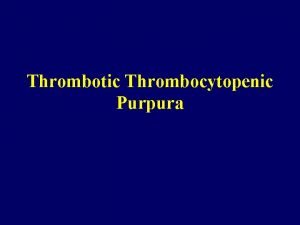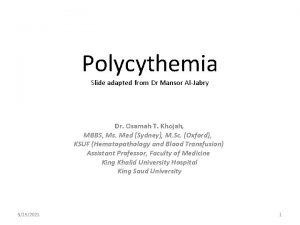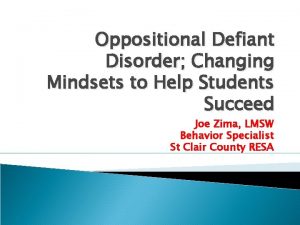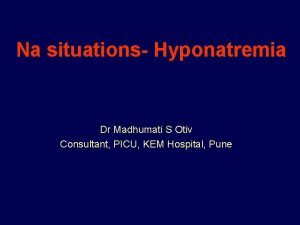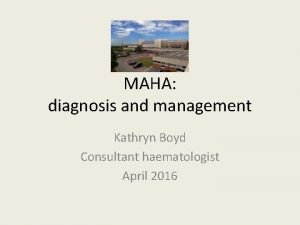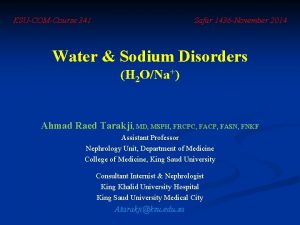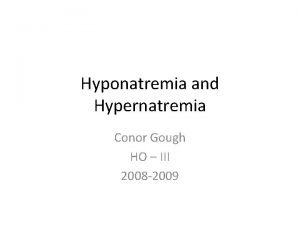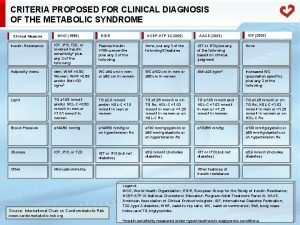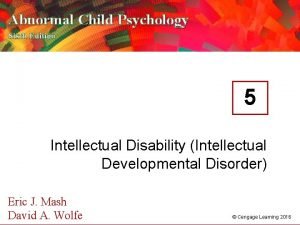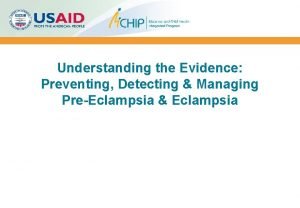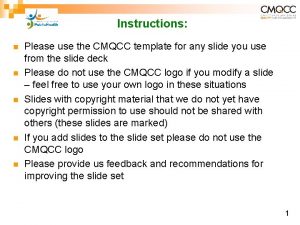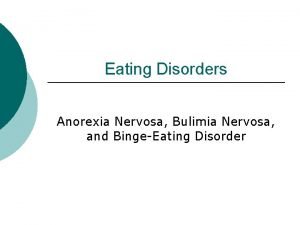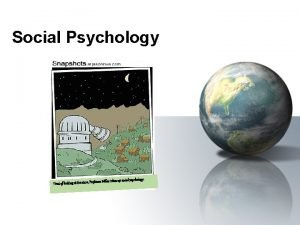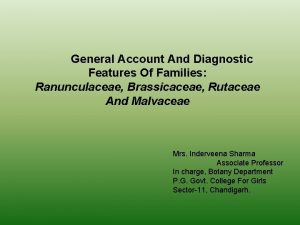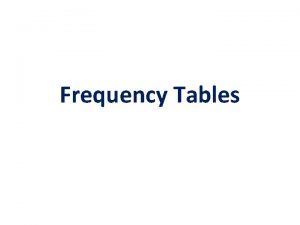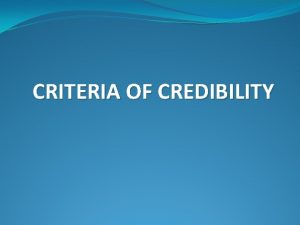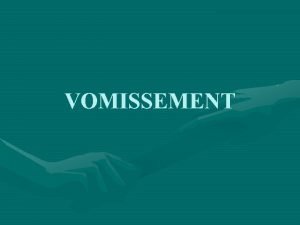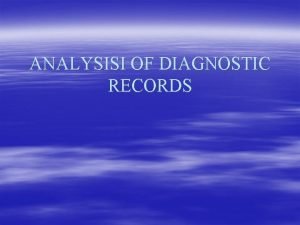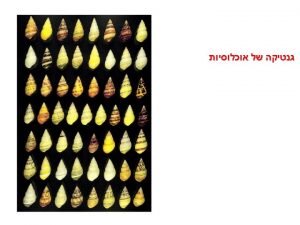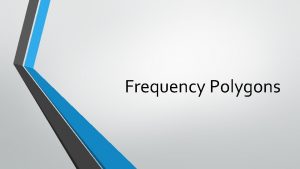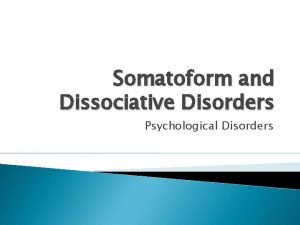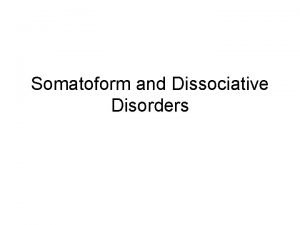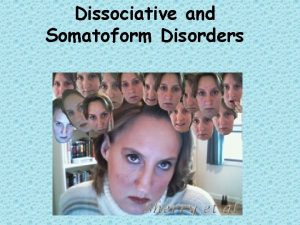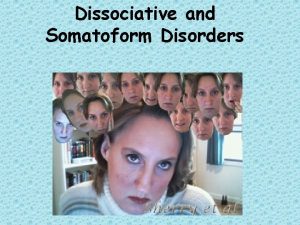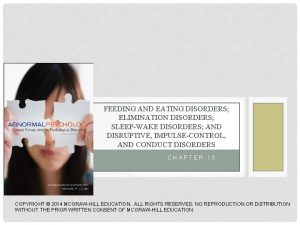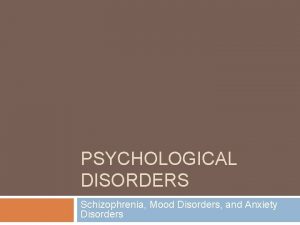Review Diagnostic Criteria Associated Features and Disorders Frequency
























- Slides: 24


Review • Diagnostic Criteria • Associated Features and Disorders • Frequency, Prevalence, and Course • Treatment Pop Culture Analysis • Slang • Famous Cases • Movies • TV

• Persistent ideas, thoughts, impulses or images that are experienced as intrusive and inappropriate and that cause marked anxiety or distress • Ego-dystonic—individual’s sense that the content of the obsession is alien, not within his or her control, and not the kind of thought he or she would expect to have • Unlikely to be related to a real-life problem • Attempt made to ignore, suppress, or neutralize obsessive thoughts or impulses with some other thought or action

Most Common Obsessions 1. Thoughts about contamination 2. Repeated doubts 3. A need to have things in a particular order 4. Aggressive or horrific impulses 5. Sexual imagery

• Repetitive behaviors or mental acts, the goal of which is to prevent or reduce anxiety or distress, not to provide pleasure or gratification • Drive to perform compulsions to reduce distress that accompanies an obsession or to prevent some dreaded event or situation • Rigid or stereotyped acts performed according to idiosyncratically elaborated rules without being able to indicate their purpose • Clearly excessive or are not connected in a realistic way with what they are designed to neutralize or prevent

Most Common Compulsions 1. Washing and cleaning 2. Counting 3. Checking 4. Requesting or demanding assurances 5. Repeating actions 6. Ordering

Criterion A : Recurrent obsessions or compulsions Criterion B : At some point during the course of the disorder, the person recognizes that the obsessions or compulsions are excessive or unreasonable • This criterion does not apply to children • In adults there is a broad range of insight into the reasonableness of the obsessions or compulsions • An individual’s insight into the disorder may vary across times and situations • Specifier: With Poor Insight—for most of the time during the current episode, the individual does not recognize that the obsessions or compulsions are excessive or unreasonable

Criterion C : Obsessions or compulsions are severe enough to be time consuming (take more than one hour per day) or cause marked distress or impairment • Significantly interfere with normal routine, occupational functioning, usual social activities, or relationships with others Criterion D : If another Axis I disorder is present, the content of the obsessions or compulsions is not restricted to it Criterion E : The disturbance is not due to the direct physiological effects of a substance or general medical condition

• Avoidance: attempts to avoid • Excessive use of substances: objects or situations that provoke obsessions or compulsions can be extensive and severely restrict general functioning • Tourette’s Disorder: incidence • Hypochondriachal concerns: repeated visits to physicians to seek reassurance • Sleep disturbances • Guilt: pathological sense of responsiblity alcohol or sedative, hypnotic, or anxiolytic medications rate ranging from 35% to 90% • Tics: between 20% and 30% of individuals with OCD report current or past tics • Dermatological problems: caused by excessive washing with water or cleaning agents

In Adults In Children • Major Depressive Disorder • Learning Disorders • Specific Phobia • Disruptive Behavior Disorders • Social Phobia • Group A Beta-hemolytic Streptococcal Infection (scarlet fever and strep throat): characterized by prepubertal onset, associated neurological abnormalities, abrupt onset of symptoms, episodic course in which exacerbations are temporally related to the streptococcal infections • Panic Disorder • Generalized Anxiety Disorder • Eating Disorders • Obsessive-Compulsive Personality Disorder • Dependent Personality Disorder • Avoidant Personality Disorder

Frequency and Prevalence • Adults: equally common in males and females Life-time prevalence: 2. 5% 1 -year prevalence: 0. 5% - 2. 1% • Children: more common in males than females Life-time prevalence: 1% - 2. 3% 1 -year prevalence: 0. 7%

Course • Modal age of onset Males: between ages 6 and 15 Females: between ages 20 and 29 • Onset is usually gradual, but cases of acute onset exist • Majority of individuals have waxing and waning course • 15% show progressive deterioration in occupational and social functioning • 5% have an episodic course with minimal or no symptoms between episodes

• Medication: SSRIs—Fluoxetine (Prozac) TACs—Clomipramine (Anafril) • Cognitive Behavioral Therapy • Exposure Therapy Touch or come close to a “contaminated” object Think dreaded thoughts deliberately for a set amount of time Resist ritualizing and accept the accompanying feelings of anxiety and discomfort

• Support Groups 1. Professionally Assisted Organized and run by a mental health professional Group therapy; an extension of individual therapy Held in therapists office; group members pay a fee 2. Mutual Support Run by individual(s) who are recovered OCD sufferers Discuss medication, symptoms, cognitive behavioral therapy Informational, not therapeutic Mental health professionals may be guest speakers Usually held in a public facility without a fee

• Support Groups 3. Twelve Step Program Run by members of Obsessive Compulsives Anonymous (OCA) Same format as the original 12 -step program Alcoholics Anonymous Network of groups throughout the United States 4. G. O. A. L. (Giving Obsessive Compulsives Another Lifestyle) Groups Founded in 1981 by a psychologist and OCD sufferer Prevent relapse with exposure and response prevention therapy in a group setting Members run the group, but a professional therapist is present

• Support Groups 5. Online Support Offer free and immediate support from other OCD sufferers, information about treatment and ways to cope, advice from medical professionals Information and advice for family members of OCD sufferers • Basic Strategy for Recovery 1. Learn to stop using rituals 2. Learn to face anxiety without them

Slang • Used as an adjective to describe a person’s perfectionist tendencies • Diminishes the severity of the disorder • Represents a lack of understanding of the disorder

Famous Cases • Marc Summers - American TV personality, producer - Best known for hosting Double Dare on Nickelodeon - Currently hosts Unwrapped and Ultimate Recipe Showdown on The Food Network

Famous Cases • Howard Hughes - American aviator, engineer, industrialist, film producer/director - Set multiple air speed records - Produced Hell’s Angels, Scarface, The Outlaw - Owned and expanded Trans World Airlines

The Aviator (2005) Character with OCD: Howard Hughes Signs and symptoms: • Rituals related to food • Fear of contamination • Excessive hand washing • Tics • Verbal repetition • Need to have things in a particular order **Says he sees things that are not there and feels like he is losing his mind** **Paranoia** Treatment: no measures taken to treat the disorder

As Good As It Gets (1997) Character with OCD: Melvin Udall Signs and symptoms: • Fear of contamination • Checking • Repeated actions • Irrational rituals **Homophobia** **Racism** **Misogyny** Treatment: medication and counseling from a psychiatrist

MTV True Life: I Have Obsessive-Compulsive Disorder (1998) • Morgan: Performs rituals to please God and keep her mother alive Therapy: Pretends to attend her mother’s funeral • Ryan: Fear of contamination, checking, tic (“huffing”) Therapy: Does not seek treatment • Jessica: Counting, irrational rituals, need to have things in a particular order Therapy: Made to resist ritualizing

Monk (2002) Character with OCD: Adrian Monk Signs and symptoms: Treatment: • Fear of contamination • Counting, ordering • Washing and cleaning • Generalized Anxiety Disorder • 38 Phobias • Avoidance • Dependent Personality Disorder • Weekly visits to his therapist, Dr. Kroger • Uses medication in a few episodes

Consider the implications if the average person’s understanding of Obsessive-Compulsive Disorder is based solely on representations in the media. • Does the media accurately represent OCD? • Does the use of OCD in slang strengthen or weaken the stigma surrounding psychological disorders? • How do comedies and dramas about OCD sufferers influence the general public’s perception of disorder? • How are aspects of the disorder exaggerated or diminished for the sake of Hollywood or “good TV? ”
 Ttp diagnostic criteria
Ttp diagnostic criteria Polycythemia vera diagnostic criteria 2021
Polycythemia vera diagnostic criteria 2021 Oppositional defiant disorder in adults
Oppositional defiant disorder in adults Siadh diagnostic criteria
Siadh diagnostic criteria Ttp diagnostic criteria
Ttp diagnostic criteria Siadh diagnostic criteria
Siadh diagnostic criteria Sodium high symptoms
Sodium high symptoms Diagnosis of insulin resistance
Diagnosis of insulin resistance Disability and psychology
Disability and psychology Eclampsia definicion
Eclampsia definicion Diagnostic criteria of preeclampsia
Diagnostic criteria of preeclampsia Criteria for bulimia nervosa
Criteria for bulimia nervosa Hashimoto encephalopathy diagnostic criteria
Hashimoto encephalopathy diagnostic criteria Chapter 8 skin disorders and diseases
Chapter 8 skin disorders and diseases Nail disease
Nail disease Out group homogeneity
Out group homogeneity Classification of ranunculaceae
Classification of ranunculaceae Chapter 18 psychological disorders review worksheet
Chapter 18 psychological disorders review worksheet What is a joint relative frequency
What is a joint relative frequency How to calculate relative frequency
How to calculate relative frequency Form factor formula
Form factor formula Vmax = aw
Vmax = aw Frequency vs relative frequency
Frequency vs relative frequency Joint frequency vs marginal frequency
Joint frequency vs marginal frequency What is conditional relative frequency
What is conditional relative frequency
